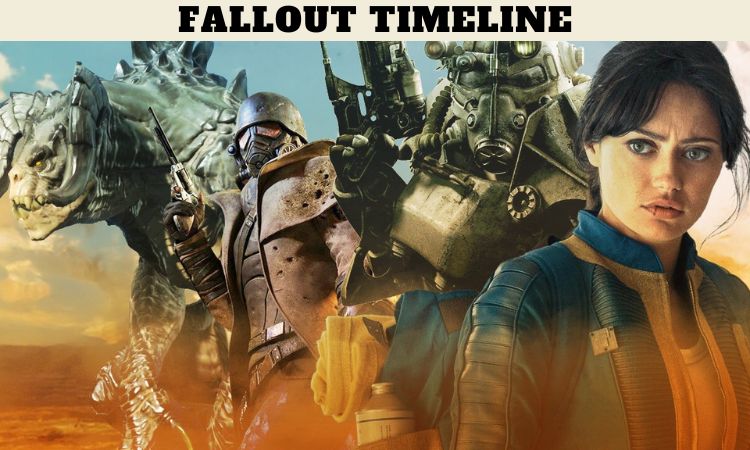
The Fallout Timeline is a fascinating and intricate narrative that spans centuries, blending post-apocalyptic fiction with alternate history. The Fallout series, developed by Interplay Entertainment and later Bethesda Softworks, is set in a world where the Cold War never ended, and nuclear annihilation reshaped civilization. The timeline is divided into two main eras: the pre-war period, which explores the events leading up to the Great War, and the post-war period, which delves into the struggles of humanity to rebuild in a harsh, irradiated wasteland. This essay will explore the key events of the Fallout Timeline, highlighting the major milestones that define this dystopian universe.
Pre-War Era: The Road to the Great War
The Fallout Timeline diverges from our own history around the mid-20th century. In this alternate universe, technological advancements focused heavily on nuclear energy and robotics, while cultural and societal progress stagnated. The 1950s aesthetic, with its retro-futuristic designs, became the dominant style, creating a world that feels both familiar and alien.
-
1945-1969: The Dawn of Atomic Age
The timeline begins with the end of World War II, much like our own history. However, in the Fallout universe, the transistor was not invented until much later, leading to a reliance on vacuum tubes and nuclear power. The United States and the Soviet Union emerged as superpowers, but tensions between them escalated rapidly. The Resource Wars of the mid-21st century were fueled by the depletion of fossil fuels, pushing nations to compete for the remaining reserves. -
2052: The Resource Wars Begin
The European Commonwealth, a coalition of European nations, went to war with the Middle East over the last remaining oil reserves. This conflict marked the beginning of global instability. Meanwhile, the United States began investing heavily in nuclear power and robotics to reduce its dependence on oil. -
2059: The Anchorage Crisis
The Anchorage Front Line was established in Alaska as tensions between the United States and China escalated over Alaskan oil reserves. The Chinese invaded Alaska in 2066, sparking the Sino-American War. This conflict would last for over a decade and become a defining moment in the Fallout Timeline. -
2077: The Great War
On October 23, 2077, the world was engulfed in nuclear fire. The Great War lasted only two hours but resulted in the near-total annihilation of civilization. The exact reasons for the war remain unclear, but it is widely believed that the United States and China launched their nuclear arsenals simultaneously. The world was left in ruins, with only a small fraction of the population surviving in underground vaults or struggling to survive on the surface.
Post-War Era: The Rise of the Wasteland
The post-war period is the primary focus of the Fallout series, exploring the struggles of humanity to rebuild in a world ravaged by radiation, mutated creatures, and the remnants of pre-war technology. This era is marked by the emergence of new factions, the rediscovery of lost technology, and the constant battle for survival.
-
2077-2102: The Early Post-War Years
Immediately after the Great War, the world was plunged into chaos. Survivors emerged from vaults and shelters to find a world transformed by radiation. Mutated creatures, such as radroaches and deathclaws, began to appear, posing new threats to humanity. Small settlements sprang up, but resources were scarce, and violence was common.In 2081, the New California Republic (NCR) was founded in Shady Sands, a small settlement in what was once California. The NCR would go on to become one of the most powerful factions in the wasteland, advocating for democracy and order.
-
2102-2161: The Rise of the Master and the Unity
In 2102, a mutant known as the Master began experimenting with the Forced Evolutionary Virus (FEV), a pre-war bioweapon. The Master sought to create a new race of super mutants, believing that they would be better suited to survive in the wasteland. His army, known as the Unity, posed a significant threat to the NCR and other factions.In 2161, the Vault Dweller, the protagonist of the original Fallout game, defeated the Master and destroyed the Unity. This victory marked a turning point in the Fallout Timeline, as it prevented the Master from achieving his goal of transforming humanity into super mutants.
-
2161-2241: The Expansion of the NCR
Following the defeat of the Master, the NCR began to expand its influence across California. By 2241, the NCR had become a major power in the wasteland, with a functioning government, military, and economy. However, the NCR’s expansion was not without challenges. The Brotherhood of Steel, a techno-religious order dedicated to preserving pre-war technology, viewed the NCR as a threat to its mission and clashed with them on multiple occasions. -
2241-2277: The Rise of the Enclave and the Second Battle of Hoover Dam
In 2241, the Enclave, a shadowy organization descended from the pre-war U.S. government, emerged from hiding. The Enclave sought to purge the wasteland of “impure” humans and mutants, believing themselves to be the last hope for humanity. Their plans were thwarted by the Chosen One, the protagonist of Fallout 2, who destroyed their base of operations in the Pacific.In 2277, the NCR and the Brotherhood of Steel clashed once again in the Second Battle of Hoover Dam. The NCR emerged victorious, solidifying its control over the region. However, the Brotherhood of Steel retreated to their bunkers, vowing to continue their mission in secret.
-
2277-2287: The Commonwealth and the Institute
In the eastern wasteland, the Commonwealth (formerly Massachusetts) became a focal point of conflict. The Institute, a secretive organization of scientists, sought to rebuild civilization through advanced technology and synthetic humans, known as synths. However, their methods were controversial, and many in the wasteland viewed them as a threat.In 2287, the Sole Survivor, the protagonist of Fallout 4, emerged from Vault 111 and became embroiled in the conflict between the Institute, the Brotherhood of Steel, the Railroad (a faction dedicated to freeing synths), and the Minutemen (a group of settlers fighting for freedom and independence). The Sole Survivor’s actions would determine the fate of the Commonwealth.
Key Themes and Legacy of the Fallout Timeline
The Fallout Timeline is more than just a series of events; it is a reflection of humanity’s resilience and capacity for both destruction and renewal. The series explores themes of survival, morality, and the consequences of technological advancement. The world of Fallout is one where the mistakes of the past continue to haunt the present, but it is also a world where hope and perseverance can lead to a brighter future.
-
The Dangers of Technology
The Fallout Timeline serves as a cautionary tale about the dangers of unchecked technological advancement. The reliance on nuclear power and the development of weapons of mass destruction led to the Great War, while the misuse of the FEV and synthetic humans created new threats in the post-war world. -
The Struggle for Power
Throughout the Fallout Timeline, various factions vie for control of the wasteland. The NCR, the Brotherhood of Steel, the Enclave, and the Institute all represent different visions for the future, but their conflicts often result in further suffering for the people of the wasteland. -
The Resilience of Humanity
Despite the horrors of the Great War and the challenges of the post-apocalyptic world, humanity endures. The Fallout Timeline is filled with stories of individuals and communities working together to rebuild and create a better future.
Conclusion
The Fallout Timeline is a rich and complex narrative that has captivated players for decades. From the pre-war era of atomic optimism to the post-war struggles of the wasteland, the series offers a unique blend of history, science fiction, and social commentary. As the Fallout series continues to evolve, the timeline will undoubtedly expand, offering new stories and insights into this unforgettable world. Whether exploring the ruins of a once-great civilization or forging a new path in the wasteland, the Fallout Timeline reminds us of the enduring power of hope and the importance of learning from the past.
Frequently Asked Questions (FAQs)
1. What is the Fallout Timeline?
Ans. The Fallout Timeline is the chronological history of the Fallout universe, which diverges from our own history in the mid-20th century. It includes the events leading up to the Great War in 2077 and the post-apocalyptic struggles of humanity to rebuild in a harsh, irradiated world.
2. How does the Fallout Timeline differ from real-world history?
Ans. In the Fallout universe, the transistor was invented much later, leading to a reliance on nuclear power and vacuum tube technology. The Cold War never ended, and the Resource Wars over dwindling fossil fuels led to global instability, culminating in the Great War.
3. What caused the Great War in 2077?
Ans. The Great War was a global nuclear conflict between the United States and China, triggered by escalating tensions over resources and political dominance. The war lasted only two hours but resulted in the near-total destruction of civilization.
4. What are Vaults, and why were they created?
Ans. Vaults were underground shelters built by the U.S. government to protect a select portion of the population from nuclear fallout. However, many Vaults were social experiments designed to test human behavior under extreme conditions, rather than genuine shelters.
5. Who are the major factions in the Fallout Timeline?
Ans. Key factions include the New California Republic (NCR), the Brotherhood of Steel, the Enclave, the Institute, the Railroad, and the Minutemen. Each faction has its own ideology and vision for the future of the wasteland.
6. What is the Brotherhood of Steel?
Ans. The Brotherhood of Steel is a techno-religious order dedicated to preserving and controlling pre-war technology. They believe that advanced technology should be kept out of the hands of the general population to prevent another apocalypse.
7. What is the Institute, and why are they controversial?
Ans. The Institute is a secretive organization of scientists in the Commonwealth that focuses on advanced technology, including the creation of synthetic humans (synths). Their methods and goals are controversial, as many view them as a threat to humanity’s future.
8. What role does the NCR play in the Fallout Timeline?
Ans. The New California Republic (NCR) is a democratic faction that emerged in the post-war wasteland. It seeks to restore order and rebuild civilization, but its expansionist policies often lead to conflicts with other factions.
9. What is the significance of the Great War in the Fallout universe?
Ans. The Great War is the defining event of the Fallout Timeline, marking the end of the pre-war world and the beginning of the post-apocalyptic era. It serves as a backdrop for the struggles and stories of the survivors in the wasteland.
10. How does the Fallout Timeline explore themes of morality and survival?
Ans. The Fallout Timeline is rich with moral dilemmas and survival challenges. Players often face difficult choices that reflect the harsh realities of the wasteland, such as deciding between self-interest and the greater good, or choosing which factions to support.


